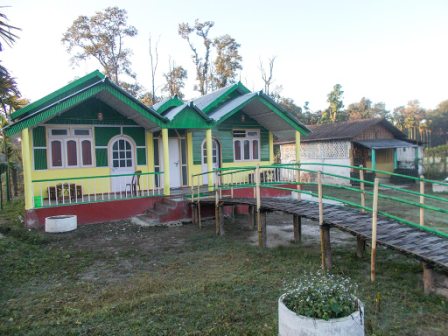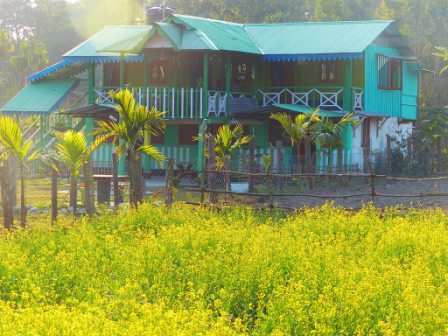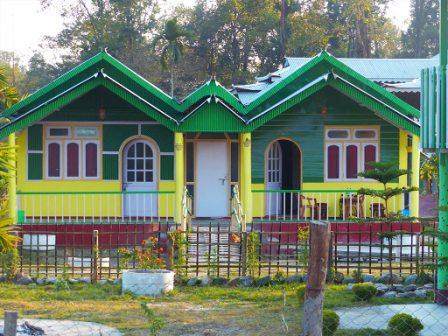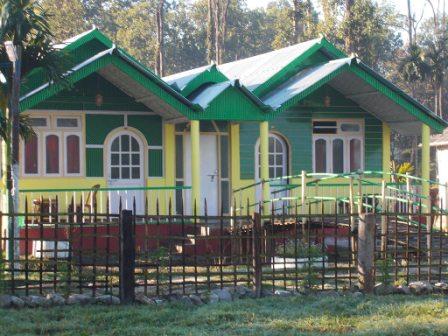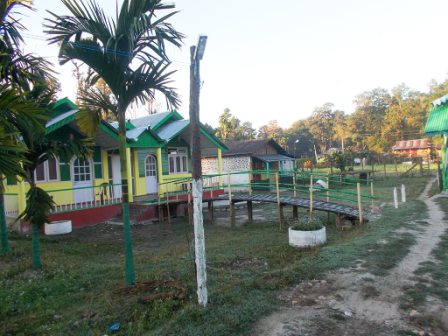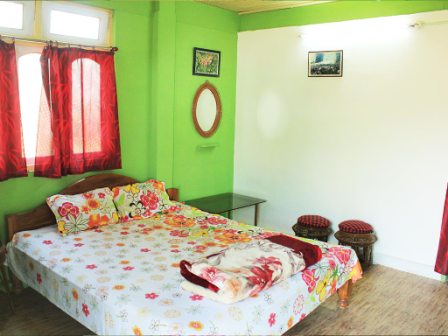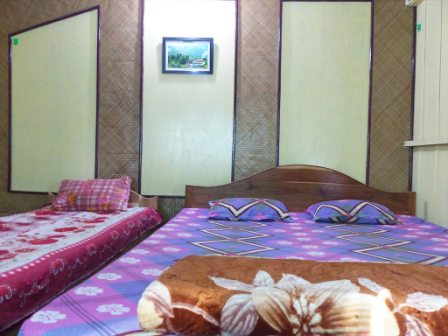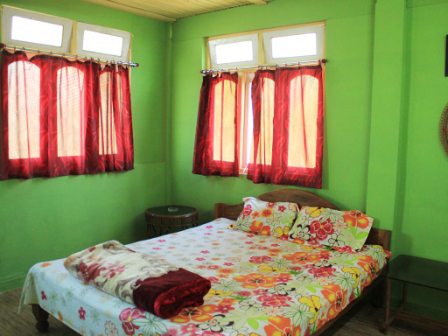BUXA TIGER RESERVE
Buxa Tiger Reserve is a Tiger Reserve and a National Park in the North-Eastern part of the Dooars region. Buxa Tiger Reserve lies in Alupurduar sub-division of Alipurduar district in the India state of West Bengal. Buxa Tiger Reserve shares the northern boundary with International border with that of Bhutan. The northern side of Buxa Tiger Reserve is guarded by Sinchula Range while the eastern boundary touches the Indian state of Assam. National Highway 31 C (NH31 C) runs through the southern boundary of Buxa Tiger Reserve. Buxa Tiger Reserve covers an area of 760 sq. km. Buxa Tiger Reserve is the eastern most extension of extreme bio-diverse North-East India and represents highly Indo-Malayan region. The fragile ‘Terai Eco – System’ constitutes a part of Buxa Tiger Reserve. The Phipsu Wildlife Sanctuary of Bhutan shares a common boundary to the north of Buxa Tiger Reserve while Manas National Park of Assam lies on the east of Buxa Tiger Reserve. Thus Buxa Tiger Reserve serves as an International corridor for elephant migration between India and Bhutan. Buxa Tiger Reserve is surrounded by about forest types. Buxa Tiger Reserve varies in altitude from 60 meter (200 feet) in the Gangetic Plains to 1750 meter (5740 feet) bordering the Himalayas in the north. Rivers like Sankosh, Raidak, Jayanti, Churnia, Turturi, Phashkhawa, Dima and Nonani flows through Buxa Tiger Reserve. Buxa Tiger Reserve is the 15th Tiger Reserve of India.
History of Buxa Tiger Reserve:
In the year 1983 Buxa Tiger Reserve was started their project with only 15 tigers and it comprises of entire forest area of erstwhile Buxa Tiger Division and some territory of neighbouring Alipurduar Forest Division. In the year 1986 Buxa Wildlife Sanctuary was constituted 314.52 km area as Reserve Forests. In the year 1991, 54.47 km area was added to Buxa Wildlife Sanctuary. Again in 1992 the government of West Bengal declared their intentions to constitute Buxa as a national park with 117.10 km of Buxa Wildlife Sanctuary. And in the year 1997 state government declared 117.10 km area of Buxa Wildlife Sanctuary as a National Park.
Biodiversity of Buxa Tiger Reserve:
Flora – Buxa Tiger Reserve:
Buxa Tiger Reserve is home to more than 450 species of trees, 250 species of shrubs, 400 species of herbs, 09 species of canes, 10 species of Bamboo, 15 species of orchids, 100 species of grass, 130 species of aquatic flora including more than 70 sedges have been traced. Apart from that more than 160 species of other monocotyledons and ferns are also found. Main species of trees found at Buxa Tiger Reserve are Sal, Champa, Gamhar, Simul and Chikrasi.
The forest types at Buxa Tiger Reserve mainly includes are Northern Dry Deciduous, Eastern Bhabar and Terai Sal, East Himalayan Moist Mixed Deciduous Forest, Sub-Himalayan Secondary Wet Mixed Forest, Eastern Sub – Montane Semi – Evergreen Forest, Northern Tropical Evergreen Forest, East Himalayan Subtropical Wet Hill Forest, Moist Sal Savannah, Low Alluvium and Savannah Woodland.
Fauna – Buxa Tiger Reserve:
Buxa Tiger Reserve is home to wide diversity of fauna including mammals, birds, reptiles and amphibians. Among these species Buxa Tiger Reserve has 390 species of birds, 73 species of mammals, 76 species of snakes and 05 species of amphibians.
Mammals species inhabit Buxa Tiger Reserve are Tiger, Leopard, Clouded Leopard, Giant Squirrel, Gaur, Chital, Wild Boar, Indian Wild Dog, Asian Elephant, Leopard Cat, Chinese Pangolin, Hispid Hare, Hog Deer, Civets, Wild Buffaloes, Antelope and many others.
Snake species found in Buxa Tiger Reserve includes King Cobra, Russell’s Viper, Black Krait, Indian Python, Reticulated Python, Regal Python, Pope’s Pit Viper, Cantor’s Kukri Snake and others.
Bird species includes Eurasian Griffon, Amur Falcon, Malayan Night Heron, Oriental Pied Hornbill, Rufous – Necked Hornbill, Chestnut – Breasted Partridge, Cinnamon Bittern, Stripe – Breasted Woodpecker, Velvet – Fronted Nuthatch, Bengal Florican and Black – Naped Oriole. Migratory birds found in Buxa Tiger Reserve are Common Merganser, Eurasian Teal, Black – Necked Crane, Black Stork and Ferruginous Pochard, Trans Himalayan Migratory Goosanders, Red – Stars, Wag – Tails, Common Teal, Black Stork, Large Whistling Teal, Minivets, White Eyed Poachared and others.
Activities and attractions in and around Buxa Tiger Reserve:
Buxa Tiger Reserve being a tiger reserve, a wildlife sanctuary and a national park offers tourists and visitors with numerous activities to try and local attractions to witness.
- Santalabari: Santalabari is a small beautiful village in the deep of Buxa Tiger Reserve core area and is one of the entry points to Buxa Tiger Reserve. Santalabari is located at a distance of 3.7 km away from Buxa Tiger Reserve. From Santalabari tourists can opt to trek to Buxa Tiger Reserve.
- Buxa Duar (Fort): The origin of the Buxa Fort was uncertain and was a point of contention between the King of Bhutan and Cooch King. Buxa Fort is located within Buxa Tiger Reserve set at an elevation of 867 meter (2844 feet) on the lap of Sinchula Hills covered with lush greenery. Buxa Fort was built by the British and was earlier used by the British as a high security prison and a detention camp. Buxa Fort was the most notorious and unreachable prison in India after the cellular jail in Andaman. The route to Buxa Fort from Buxa Tiger Reserve is quiet steep but not troublesome. Later Buxa Fort was used as a refugee center to give shelter to the Tibetan Refugee during the Chinese invasion in the year 1959. Buxa Fort is located at a distance of 05 km from Santalabari.
- Rovers Point: Rovers Point is a splendid hilltop viewpoint located at a distance of 03 km away from Buxa Fort. Rovers Point offers tourists and photographers a good chance to spot their camera for some of the best landscape shots as it peaks into the densely forested valley.
- Lepchakha Village: Lepchakha is a Drukpa tribe inhabited village set at an altitude of 3500 feet and is located at a distance of 05 km from Buxa Fort. Lepchakha village is located close to Indo – Bhutan border and is a less trodden destination of Dooars region.
- Rupam Valley: Rupam Valley or Rupang Valley is village on the Himalayan foothills located on Tashigaon – Lepchakha trek route. The trek to Rupang starts from Buxa Fort area and goes via Rovers Point. Rupang Valley is set at an altitude of 5231 feet and this whole trek takes 03 to 04 days to complete. The route to Rupang Valley leads through thick natural vegetation with numerous birds and butterflies often spotted. Rupang Valley is located at a distance of 14 km from Santalabari.
- Jayanti: Jayanti is a small forest village within Buxa Tiger Reserve lies along the banks of River Jayanti forming a natural border between India and Bhutan. From Buxa Fort a trek of 13 km will reach at Jayanti and the route passes through the dense wilderness of Buxa Tiger Reserve. The village of Jayanti is mainly known for its serene landscape, lush green tea gardens, Jayanti River and the view of the Bhutan hills at the backdrop.
- Mahakal Temple: The Mahakal Temple at Jayanti is a must visit place from Buxa Tiger Reserve located at a distance of 05 km away from Jayanti River. The Mahakal Temple and Cave is a Hindu pilgrimage site mainly known for its Stalactite and Stalagmite structures. The Mahakal Temple and Cave is located on Bhutan border and is mostly visited during Shivratri. Tourists are refraining to visit the temple cave during monsoon season. The Mahakal Temple and Cave has three chambers. The first one has idols of Brahma, Vishnu and Maheshwara. The second chamber has idol of Lord Shiva and the third chamber has idol of Goddess Mahakali.
- Rajabhatkhawa: Rajabhatkhawa is a small town just outside Buxa Tiger Reserve in the Kalachini CD block of Alipurduar sub division. Rajabhatkhawa is the main entry point to Buxa Tiger Reserve located at a distance of 02 km away. Entry permits to Buxa Tiger Reserve are mainly issued from Rajabhatkhawa. Rajabhatkhawa is mainly known for its lush green environment along with Interpretation Center, Orchidarium and Rescue Center.
- Pokhri Hill: Pokhri Hill is a must visit spot from Buxa Tiger Reserve located at a distance of 04 km short trek from Jayanti village in Buxa Tiger Reserve. At Pokhri there is small pond situated on the hill top and is a place of worth visit to experience the natural environment.
- Village Trails: In and around Buxa Tiger Reserve there are about 37 villages located nearby which are mostly inhabited by the local tribal people or the indigenous people. These are namely 29 Mile Village, Bhutia Basti and 28 Mile Village and many others which are worth visiting. Among those 15 villages are within the core area and have been relocated to different places. Tourists can opt for a village trail to some of these villages for a day trip.
- Sikia Jhora: Sikia Jhora is a small quaint river or a narrow creek surrounded by the dense mixed wet forest in the Buxa Tiger Reserve. Recently a dam has been constructed at Sikia Jhora which attracts numerous tourists from far and wide. Tourists can also opt to hire boat ride through Sikia Jhora and witness the surrounding wilderness along with numerous birds. Sikia Jhora is located at a distance of 14 km away from Buxa Tiger Reserve.
- Raimatang: Raimatang is another small forest village situated along the banks of River Raimatang in Buxa Tiger Reserve. Raimatang is located at a distance of 39 km away from Buxa Tiger Reserve. Raimatang is surrounded by ever green forests, hills and river. Raimatang is popular among tourists for its scenic landscape along with wide species of birds and butterflies.
- Jungle Safari: At Buxa Tiger Reserve tourists can opt for forest safari through the dense wilderness. Tourists need to get the entry permit for forest safari at Buxa Tiger Reserve from the forest office at Rajabhatkhawa or Jayanti. Inside Buxa Tiger Reserve mainly jeep safari is conducted. This safari held two times in a day. One is from 06 am to 11 am, and the other is from 02 pm to 06 pm. This jeep safari inside Buxa Tiger Reserve covers an area of 17 km long. Tourists are required to take a guide along with them during the jeep safari.
- Bird Watching: Buxa Tiger Reserve is a prime and ideal location for bird watchers as the reserve forest in home to wide species of birds which are spotted in and around the forest.
- Landscape Photography: Buxa Tiger Reserve offers landscape photographers with excellent opportunities for landscape photography. The surrounding wilderness along with the rising hills with flowing rivulets offers landscape photographers with some of the best shots.
- Hiking: Buxa Tiger Reserve offers tourists with the option to take part in hiking and trekking activity. Several small and steep routes emerged from Buxa Tiger Reserve which leads to different parts of the forest.
Getting to Buxa Tiger Reserve:
By Air: Bagdogra Airport is the nearest airport to Buxa Tiger Reserve located at a distance of 164 km via NH 27. Bagdogra Airport is well connected by regular flight services with Kolkata, Delhi and Guwahati. From Bagdogra Airport tourists need to hire vehicles to reach Buxa Tiger Reserve.
By Train: New Alipurduar railway station is the nearest rail head to Buxa Tiger Reserve located at a distance of 15 km away. Apart from that there are few other railway stations from where one can easily reach Buxa Tiger Reserve, these are namely New Cooch Behar railway station located around 31 km away, Kokrajhar (At Assam) is located at a distance of 78 km away, New Jalpaiguri railway station is located at 164 km away, Hashimara railway station is located at 37 km away and Jalpaiguri railway station is located at 127 km away. From all these railway stations tourists will get hired vehicle services to reach Buxa Tiger Reserve.
By Road: Buxa Tiger Reserve is well connected by good motor-able roads with all the nearby places. Buxa Tiger Reserve can be easily approached from Jaldapara (46 km), Gorumara National Park (113.4 km), Murti (103 km), Cooch Behar (39.9 km), Phuentsholing – Butan (38.9 km), Siliguri (162.4 km) and Alipurduar (15 km). From all these places tourists will get vehicle services to reach Buxa Tiger Reserve.
Best time to visit:
Buxa Tiger Reserve can be visited from mid – September to mid – June, as during this time the forest remains open. From mid – June to mid – September Buxa Tiger Reserve remains closed for tourists visit. Apart from this October to March is the best time to visit Buxa Tiger Reserve as during this time the climate remains very pleasant making it very comfortable for tourist movement.
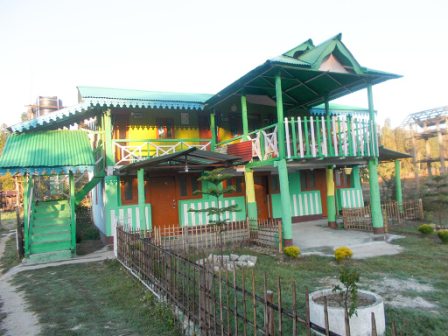
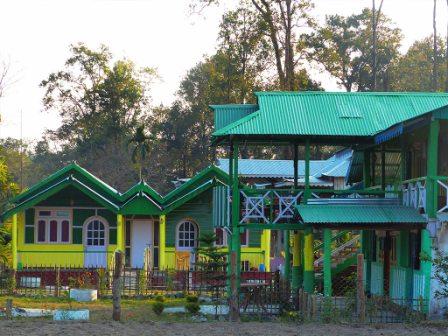
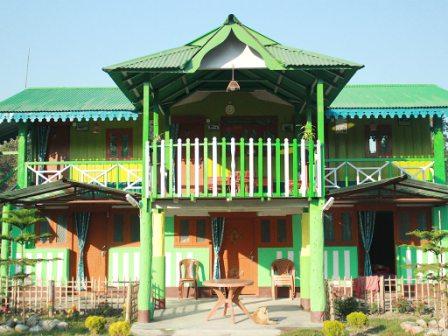
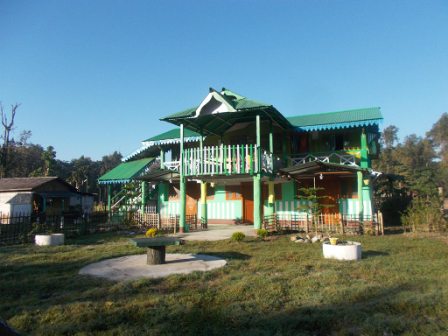
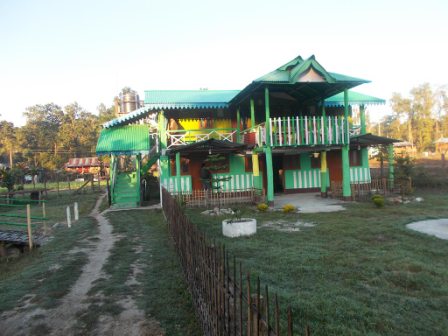
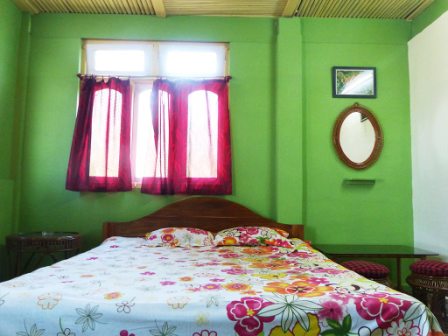
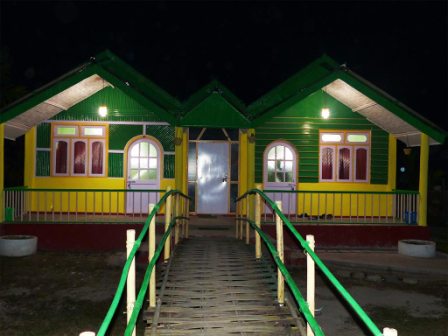
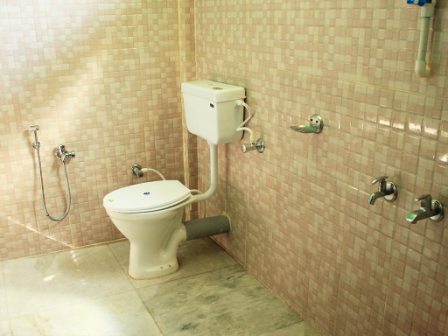
BUXA ECO HUT HOMESTAY
Buxa Eco Hut Homestay is the only accommodation available at this village 29 Mile. The Eco Hut is very well decorated with wooden furnished rooms, all rooms are with attached bath rooms. In house restaurant arrangements are also available and arrangement for local sight scene.
Room Tariff:
Double Bed Rooms @ 1200/- per day per room.
Four Bed Rooms @ 1500/- per day per room.
Package rate @ 1350/- per day per person (both food and lodging included)
Meals Includes: Bed tea, breakfast, lunch, evening snacks, tea and dinner
Service charge @ 10% on the room tariff.
HOW TO BOOK: Call us at 9831311606, 9830381306 to get the current availability status or use the query form furnished below with all you travel queries and submit, we will call/ contact you directly.
Or, you may also directly book from our Kolkata office at: 8C Shanti Ghosh Street, Kolkata – 700003. Nearest Landmark: Manindra Chandra College and Shyambazar Metro Railway Station (Gate No: 3)
